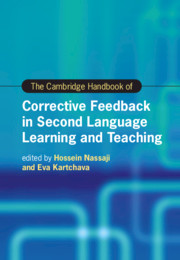Book contents
- The Cambridge Handbook of Corrective Feedback in Second Language Learning and Teaching
- Cambridge Handbooks in Language and Linguistics
- The Cambridge Handbook of Corrective Feedback in Second Language Learning and Teaching
- Copyright page
- Contents
- Figures
- Tables
- Contributors
- Acknowledgments
- Introduction Corrective Feedback in Second Language Teaching and Learning
- Part I Theoretical Perspectives on Corrective Feedback
- Part II Methodological Approaches in the Study of Corrective Feedback
- Part III Different Delivery Modes of Corrective Feedback
- Part IV Feedback Provider, Feedback Intensity, and Feedback Timing
- Part V Corrective Feedback and Language Skills
- Part VI Contexts of Corrective Feedback and Their Effects
- 22 Corrective Feedback in Second versus Foreign Language Contexts
- 23 Corrective Feedback in Computer-Mediated versus Face-to-Face Environments
- 24 Corrective Feedback in Mobile Technology-Mediated Contexts
- 25 Oral Corrective Feedback in Content-Based Contexts
- Part VII Learners’ and Teachers’ Feedback Perspectives, Perceptions, and Preferences
- Part VIII Individual Differences, Tasks, and Other Language- and Learner-Related Factors
- Index
- References
25 - Oral Corrective Feedback in Content-Based Contexts
from Part VI - Contexts of Corrective Feedback and Their Effects
Published online by Cambridge University Press: 26 February 2021
- The Cambridge Handbook of Corrective Feedback in Second Language Learning and Teaching
- Cambridge Handbooks in Language and Linguistics
- The Cambridge Handbook of Corrective Feedback in Second Language Learning and Teaching
- Copyright page
- Contents
- Figures
- Tables
- Contributors
- Acknowledgments
- Introduction Corrective Feedback in Second Language Teaching and Learning
- Part I Theoretical Perspectives on Corrective Feedback
- Part II Methodological Approaches in the Study of Corrective Feedback
- Part III Different Delivery Modes of Corrective Feedback
- Part IV Feedback Provider, Feedback Intensity, and Feedback Timing
- Part V Corrective Feedback and Language Skills
- Part VI Contexts of Corrective Feedback and Their Effects
- 22 Corrective Feedback in Second versus Foreign Language Contexts
- 23 Corrective Feedback in Computer-Mediated versus Face-to-Face Environments
- 24 Corrective Feedback in Mobile Technology-Mediated Contexts
- 25 Oral Corrective Feedback in Content-Based Contexts
- Part VII Learners’ and Teachers’ Feedback Perspectives, Perceptions, and Preferences
- Part VIII Individual Differences, Tasks, and Other Language- and Learner-Related Factors
- Index
- References
Summary
This chapter investigates oral corrective feedback (CF) in content-based contexts. Specifically, it examines how CF can play a unique and necessary role in these contexts as a means of integrating language into content instruction. However, based on studies showing teachers’ reluctance to use CF, this chapter also outlines how CF may come into direct conflict with other content-based pedagogical objectives. Owing to the great amount of diversity found among content-based contexts, this chapter considers both cross-context, CF-related issues that can inform all content-based programs as well as issues regarding CF’s use and effectiveness in specific contexts.
Keywords
- Type
- Chapter
- Information
- The Cambridge Handbook of Corrective Feedback in Second Language Learning and Teaching , pp. 539 - 558Publisher: Cambridge University PressPrint publication year: 2021
References
- 1
- Cited by

